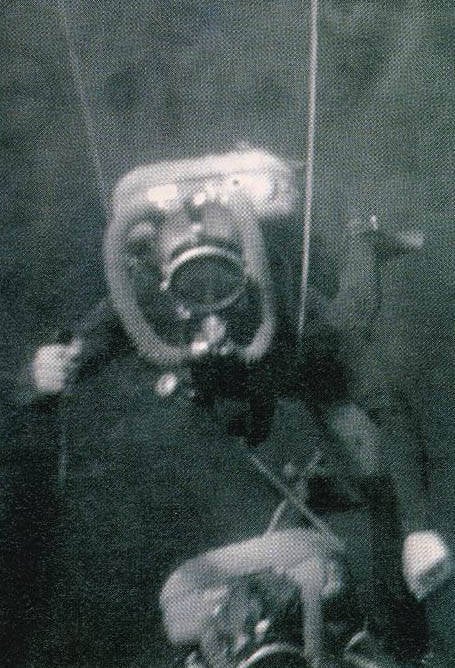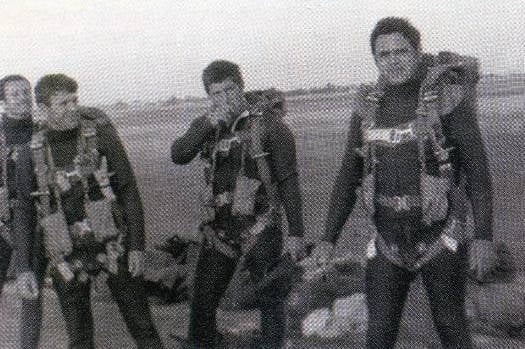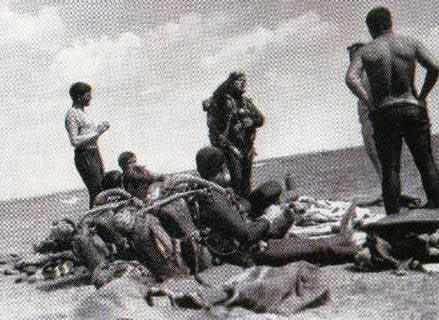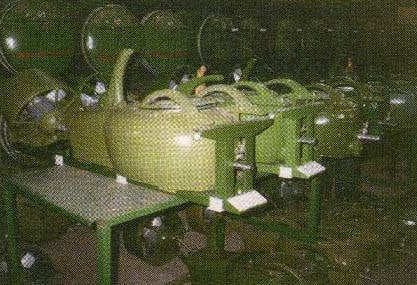Amphibian Man. Special Forces of the Soviet Navy
Marine Special Forces
Various names that hid their true purpose still confuse the pages of newspapers and magazines. They are confused with the Marine Corps, they are listed on either the Vympel or the Alpha, in American style they are called “sea lions”, they say with certainty that they are PDSS (anti-sabotage forces and means, which, by the way, have a completely opposite task).
Few managed to meet and talk with those who served in these really secret parts. I was lucky to be the commander of a group of naval special forces for six years, so I hope to bring some clarity to this issue.
The closeness of this topic, which is even now under the heading “owls. secretly, ”is clear from the tasks facing combat swimmers. This is coastal intelligence fleetthe destruction of mobile launchers, command posts, air defense systems, hydraulic structures, ships, ships - and much more, where accurate calculation, excellent physical and technical training, dedication and faith in those who are close to you are required. Many tasks performed by special forces of the Navy often seem impossible, but the fact that the enemy excludes even the possibility of their fulfillment allows combat swimmers to achieve success.
Swimming in the storm
 Military swimmers were assigned to conduct reconnaissance on coastal directions, the destruction of mobile launchers, command posts, air defense systems, hydraulic structures, ships, ships - and much more that require accurate calculation, excellent physical and technical training.
Military swimmers were assigned to conduct reconnaissance on coastal directions, the destruction of mobile launchers, command posts, air defense systems, hydraulic structures, ships, ships - and much more that require accurate calculation, excellent physical and technical training.9 July 1986 of the year. One of the southern cities of the then USSR, a group of three swimmers consisting of three people, set the following tasks: to implement a conditional breakthrough of the USSR sea border between 15.00 and 16.00, sailing to the outer roadstead (distance 6 nautical miles - approximately 11 km), where the “foreign vessel” stood (ship mediator). The task was set to us by the command of the border area in order to check the combat readiness of its units, which explains the time, which is ridiculous for such operations, in broad daylight. In other words, the task presupposed our failure.
But we decided not to fail. They made additional exploration, and since the area of the breakthrough was determined in the city, the group, dressed in civilian clothes, under the guise of vacationers, identified patrol routes and patrol mode. The greatest difficulty was to change into diving equipment and find yourself in the water. The preliminary calculation was that there would be a lot of swimmers on the shore, but that day, as luck would have it, drizzled light rain, a strong wind was blowing from the sea. Therefore, we had to put on diving equipment (wet type!) Under clothes, then seep one by one into the concentration area near the sea coast, using “holes” in patrols and bypassing “secrets”.
Taking off their clothes, disguising them and capturing the rest of the equipment, the group slipped unnoticed into the water. The first meters of the 70 group sailed under water, and then the 20 swimmers swam for XNUMX minutes using a special technique, appearing above the surface of the water just for inhaling. A strong wind raised high waves, which we used as a cover.
The patrol boats passed so close that people’s faces were visible on the deck, but the group went unnoticed. Swimmers floated, guided by a compass, they were in the water for about five hours, swimming more than 10 kilometers in the stormy sea, but the task was successful (not for border guards) ...
Ferocious selection
The special forces of the Navy had only a few units (by the way, after the collapse of the USSR, the most combat-ready part of the naval special forces went to Ukraine). Selection in these parts was very strict. Many of the conscripts did not even know exactly where they were selected before arriving at the unit. Before being drafted into the army, young men with sports classes were given light diving and parachute training at DOSAAF, of which candidates were selected at the recruiting stations by special officers, from which the training squad was formed for additional training.
For six months, they were trained under a special program, where physical and psychological stress was close to the limit. The candidates were constantly supervised by sergeants from combat units, who selected people in advance in groups. Physical, vocational training was assessed according to standards, and psychological stability was tested according to the results of various tests. For example, such a test could be a march at night without specifying the distance and time of the run. Towards morning, when complete physical exhaustion occurs, it is psychological stability that begins to manifest itself. Only a few are able to run, not paying attention to the legs knocked into the blood, to the tired fatigue. Those who passed this and other numerous tests were enrolled in combat units.
The service life was three years. The combat training program was very diverse and included diving, airborne, navigation-topographic, mountain special, maritime, physical training, mine-disruptive business, hand-to-hand combat, survival in various conditions, foreign armies and theater of military operations, radio equipment and much more, without which it can not do in a modern war.
Equipment - match tasks
To perform a wide range of tasks, combat swimmers had to have in their arsenal at least a wide arsenal of weapons and technical equipment.

Since the fighting had to take place not only on land, in addition to all types of conventional small arms, swimmers had an underwater pistol and an underwater gun APS, which made it possible to hit targets both underwater and on land. Special weapon used for silent and flameless shooting and included various pistols and machine guns and a scout's shooting knife (LDC). To enhance the firepower of the group could be armed with grenade launchers, flamethrowers, MANPADS, ATGM.
The rifle training in the units received great attention. Thanks to the care of the fleet command, we were not subject to restrictions on the issuance of ammunition. For example, for one shooting, a group of ten people fired thousands of rounds of ammunition and 1,5 – 2 grenades from a grenade launcher in 8 – 16 exercises, and a part of the whole spent annually 5 – 7 rounds of ammunition.
The main emphasis in the preparation was on the rapid defeat of the target in various situations from the first shot. The mode of fire when performing exercises was set to a single, with a high rate of fire, with a constant change of positions, although the rifle instructions of those years required only automatic fire. The effectiveness of our version of the shooting was confirmed by time.
Engineering weapons were also quite diverse and included conventional explosives, standard army charges, both high-explosive and cumulative, anti-personnel and anti-tank mines, as well as special anti-ship mines.
We could all
Combat swimmers learned how to mine objects on land and in water, deactivate minefields, make mine traps from improvised means, calculate charges and much more. Excellent engineering skills were achieved by constant practical training. BB released for classes also without delay and restrictions.

For confident work with warheads and mines, respect for explosives and solid theoretical knowledge are necessary. Respect was worked out with concrete examples, which, perhaps, were not always in the spirit of “guiding documents”, but very effectively achieved the goal. You can say a hundred times about security measures when dealing with explosives, but much more convincingly when Ka-Deshke (a detonator capsule weighing less than 3 g) carries the box from the cartridges to slivers - and there are no more willing to stick it in your pocket or pick it up wand.
The main task of the groups is actions in the rear of the enemy. Delivery of combat swimmers to objects could occur in several ways: ground, air, sea. Amphibious parachutes D5, D6, PV-3 were used for landing airplanes and helicopters. The latter allowed the swimmer to land in diving equipment on the water. The reliability of the PV-3 is indicated by the fact that it was used in the landing test from supersmall heights, which was carried out in a unit on the Black Sea Fleet in June 1986. Then we practiced jumps from 120, 100, 80 and 60 meters. And Colonel V. Pozdnyakov made a record jump with 50. The jumps from the super low heights were made without a spare parachute, since the time under the dome was still seconds. High preparedness allowed us to jump without injury at wind speed 14 m / s, and on some exercises I had the opportunity to parachute at wind 17 m / s. In addition to conventional parachutes, various cargo parachute systems were used.
Under the water

Diving training is what defined our name. Our main equipment was the IDA-71 apparatus and the AVM-5 scuba diving gear used to provide diving descents. The IDA-71 devices are reliable, but require a high level of training from the diver. Confident possession of them was achieved only through long training.
Even after a short dive under all the seekers of romance, illusions disappeared, and when walking in the apparatus to full autonomy after coming out of the water, even close friends did not always recognize the swimmers. What to do: our UGK-3 overalls were far from ideal in terms of comfort. But the device IDA-71 allowed with proper use squeeze out of it in 1,5 times the standard time under water.
Diving equipment was complemented by hydroacoustic stations, navigation devices and many others. For the movement under water, individual towers, group carriers and ultra-small submarines were used. These technically sophisticated devices greatly facilitated the execution of tasks, but the main character was still a combat swimmer, his fitness and physical endurance. People in rubber overalls opposed themselves to the metal of ships.
Masters of all trades
On one of the workouts of combat training tasks, a group carrier unexpectedly sank. Since the depth allowed, the crew did not leave it and continued to fight for the salvation of the product. The emergency blowing system did not work (the engineer preparing the product forgot to open the valve on the emergency blowing cylinder). After some time, the sergeant, who was sitting in the second cabin, ran out of oxygen, and he had to ascend on the orders of the commander. The officer remained under water and continued his attempts to “revive” the equipment. Oxygen began to run out at him too - and at that moment it was possible to turn on the pump of the surge tank and float to the surface. In the surface position, the crew returned to the base.
Multilateral preparedness of combat swimmers was required when guarding our ships during the youth festival in Cuba, during the meetings of Mikhail S. Gorbachev in Reykjavik and in Malta, where it was the naval combat swimmers who were guarding under water (and not the KGB, which didn’t had combat swimmers of sufficient readiness - not to mention the underwater means of movement). In the initial period of the division of the Black Sea Fleet, swimmers were guards of the fleet commander Kasatonov during his trips to Georgia. Combat swimmers had to tackle many other tasks: this is the search for aircraft that fell into the sea and at shallow depths, the disposal of unexploded ordnance, the search for dangerous criminals in a mountainous wooded area, and the elimination of the consequences of technical disasters (for example, 1995 in summer). year in Kharkov).
It was possible for them to take part in the tragic stories passenger fleet - to lift the bodies of the dead from the sunken motor ship “Nakhimov” in August-September 1986. The combat swimmers examined the hull of the vessel, searching for clusters of the dead, using sea mines, pierced the holes in the board, through which the bodies removed the heavy divers - “tricollers” . As the ship lay at the maximum depth for this type of equipment, our midshipman Yu. Polishchuk died as a result of a tragic accident.
Checks for lice
In the process of training combat missions, combat swimmers were attracted several times a year to check the combat readiness of units and subunits of naval bases and their ability to repel an attack by enemy saboteurs. We at these exercises, in turn, worked out the methods of disembarkation, the tactics of covert penetration, the seizure of valuable prisoners, documents and much more.
The experience of the exercises of these years shows the high efficiency of actions of groups of combat swimmers, who, despite the number of all in 6 – 10 people, achieved very high results. We blocked the mine settings of the Navy, mined ships, air defense facilities. Almost always swimmers emerged victorious from an unequal duel: a dozen people, on the one hand, and a naval base (dozens of ships and thousands of people), on the other. Even then, the commanders of our groups in the reports on the results of the exercises indicated the weak anti-sabotage security of many objects, which is confirmed now.
Sturm "Comet" in seven seconds
Another task, worked out by combat swimmers, was the struggle against the seizure of ships by terrorists. At that time it was a purely theoretical question, but the hijacking of aircraft already occurred quite often. Therefore, in October 1988, together with the KGB and the Ministry of Internal Affairs, we conducted an exercise to free the captured hydrofoil ship Kometa. According to the scenario, “Comet” was stopped by border boats, negotiations were held with the terrorists. Two options were tested: underwater and above-water. Four subgroups each had their own task. Using the dead zones of the wings of the Comet, they concentrated on the simultaneous storming of the vessel. Weapons - special, noiseless, which during the assault was fixed for insurance on the body of each swimmer. For a quick climb on the wings of the Comet, light ladders (ladders) with zero buoyancy were used.
After giving the signal, the first two subgroups captured the first bow saloon and the captain's cabin. The second two - central and aft salons. The main targets of suppression were people with weapons or resisting. The whole operation to capture and destroy the three "terrorists" took seven seconds.
Currently, the Navy's combat swimmers, like our entire army, are going through difficult times, although the level of preparedness is still very high. But people leave, invaluable experience is lost, for which it is paid in blood and sweat. It’s time, given the experience of recent local wars, to approach the creation of unified forces of special operations, when the entire operation to reconnaissance, seize or destroy an object would be carried out by unified special forces (special groups, aviation, firearms) without the involvement of extraneous forces and means.
I would like to hope that in the Russian armed forces naval special forces swimmers will still occupy a worthy place.
Information